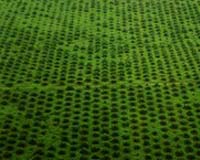 |
Manhattan KS (SPX) Nov 04, 2009 Two Kansas State University engineers are assessing systematic production methods that could make the costs of algae oil production more reasonable, helping move the U.S. from fossil fuel dependency to renewable energy replacements. The idea by K-State's Wenqiao "Wayne" Yuan and Zhijian "Z.J." Pei is to grow algae in the ocean on very large, supporting platforms. The National Science Foundation awarded them a $98,560 Small Grant for Exploratory Research in 2009 for their work. Compared to soybeans that produce 50 gallons of oil an acre a year, some algae can average 6,000 gallons - but it's not cheap to produce. Current algae growing methods use ponds and bioreactor columns, and algae float around suspended in water. Harvesting such a moving target systematically requires using very costly inputs like centrifuges and electricity. Even with these best technologies for algae growth and production, the end product biodiesel is expensive at about $56 a gallon. Yuan, assistant professor of biological and agricultural engineering at K-State, thinks it will be five to 10 years scientists before understand the fundamentals of large-scale algae production sufficiently that cost can be reduced to the target of about $5 a gallon. "It will take that much time to really understand the fundamentals of large-scale algae production and to establish pilot projects," he said. Both Yuan and Pei, professor of industrial and manufacturing systems engineering at K-State, think food production land should not be used to produce algae for fuel. The two are studying the feasibility of large-scale algae production in the ocean and how to engineer the production systems. Pei and Yuan are working to identify oil-rich algae species that are inclined to settle down and grow en masse on a solid surface, a characteristic that will make algae production manageable and harvesting much simpler. "We think there is tremendous potential for algae oil production if we grow it on big platforms and incorporate the ocean into the system," Yuan said. Half the cost of growing algae is in providing a steady supply of food and water, the growth medium. Ocean water offers those in abundance, he said. The researchers are currently addressing several broad questions: By what mechanisms do algae attach to various surfaces, what materials do algae prefer, and what surface textures, if any, encourage the algae to bloom and grow? Pei said the research team has achieved some exciting results. In studies of two species of algae characteristically high in oil content and fast growing, both species attached very well to a stainless steel, thin film surface that was slightly dimpled. Furthermore, once the algae attach, they grow very well, producing a green clump several millimeters thick. "Just like geckoes cannot walk on a perfectly smooth surface, our results indicate that the algae attach better on a slightly textured surface," Yuan said. Stainless steel was chosen because it is easy to machine or texture, durable and reasonably cheap. A colleague at Northwestern University produced the dimpled samples used in the study. "We are doing very fundamental research now," Yuan said. "We need to understand the algae attachment mechanism before we can select species more likely to attach to a solid support." Pei and Yuan think large-scale algae production done on very large support surfaces in ocean water is quite feasible. They are imagining a long, continuously rolling surface like a conveyer belt. "Right now, we really are thinking in terms of a large-scale biological and mechanical production system," Yuan said. As Yuan describes the system, the algae would grow on the thin-film surface submerged under the ocean. At some point, the growth surface rolls up into the sunlight and the algae dries. A harvesting knife at the end of the conveyer system scrapes off dried algae, at which point the surface submerges to become home to the next growth of oil-rich algal material. In August, Yuan and Pei and associates presented results of the surface studies at the 59th general assembly of CIRP, the International Academy for Production Engineering, in Boston. The academy is the only global organization representing the latest research and development activities in the area of production engineering. Their presentation was "Effect of Surface Texture on Algae Growth." Co-authors with Pei and Yuan are Yan Cui, K-State graduate student in biological and agricultural engineering; and Northwestern University colleagues Jian Cao and Michael Beltran, professors, and Tiffany Davis, a graduate student. The Journal of Manufacturing Science and Engineering, a CIRP publication, has accepted their paper, "Feasibility Study of a Mechanical-Biological Energy Manufacturing System," for publication. Share This Article With Planet Earth
Related Links K-STATE Bio Fuel Technology and Application News
 European palm oil buyers shunning eco-friendly variety: WWF
European palm oil buyers shunning eco-friendly variety: WWFKuala Lumpur (AFP) Nov 2, 2009 European palm oil buyers who are refusing to purchase expensive eco-friendly palm oil were named and shamed Monday by environmental campaigners WWF International. Only 10 out of the 59 major retailers and manufacturers surveyed in an industry scorecard have lived up to their commitments to buy "sustainable" palm oil which is manufactured according to strict standards, it said. At an indu ... read more |
|
| The content herein, unless otherwise known to be public domain, are Copyright 1995-2009 - SpaceDaily. AFP and UPI Wire Stories are copyright Agence France-Presse and United Press International. ESA Portal Reports are copyright European Space Agency. All NASA sourced material is public domain. Additional copyrights may apply in whole or part to other bona fide parties. Advertising does not imply endorsement,agreement or approval of any opinions, statements or information provided by SpaceDaily on any Web page published or hosted by SpaceDaily. Privacy Statement |